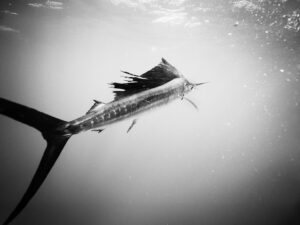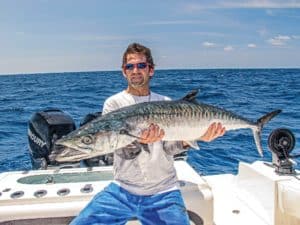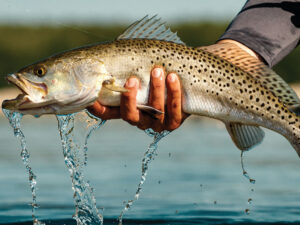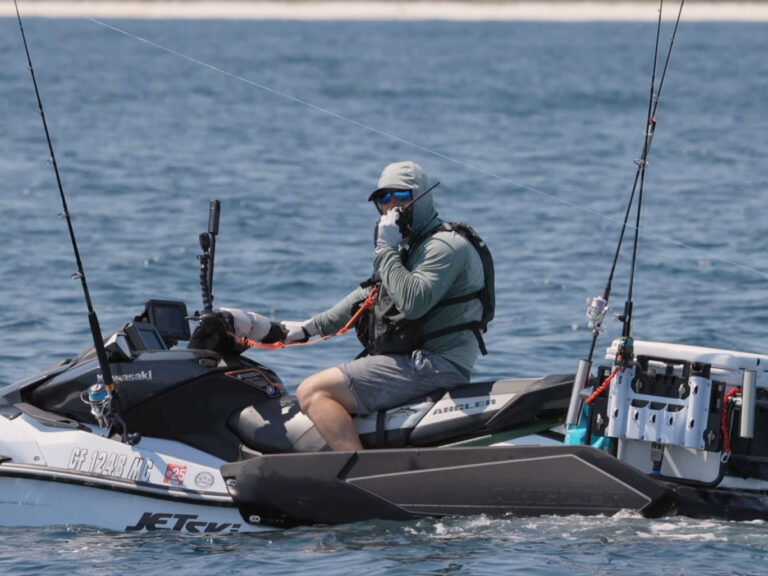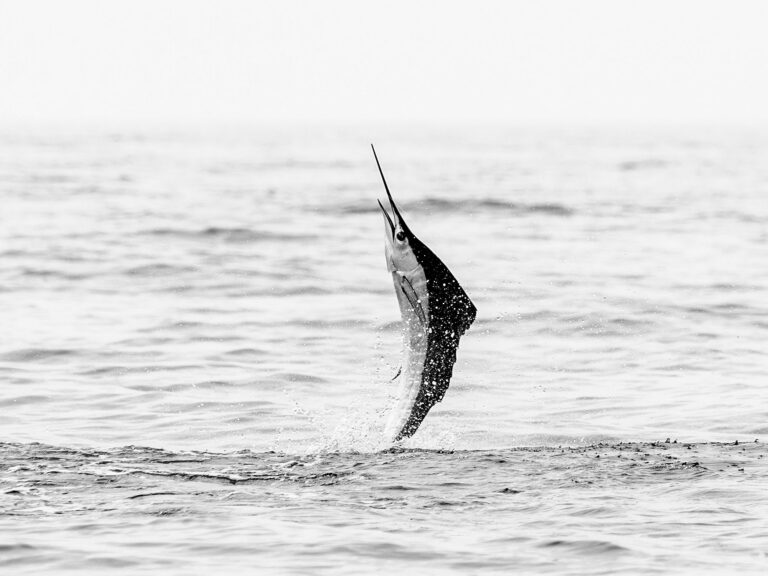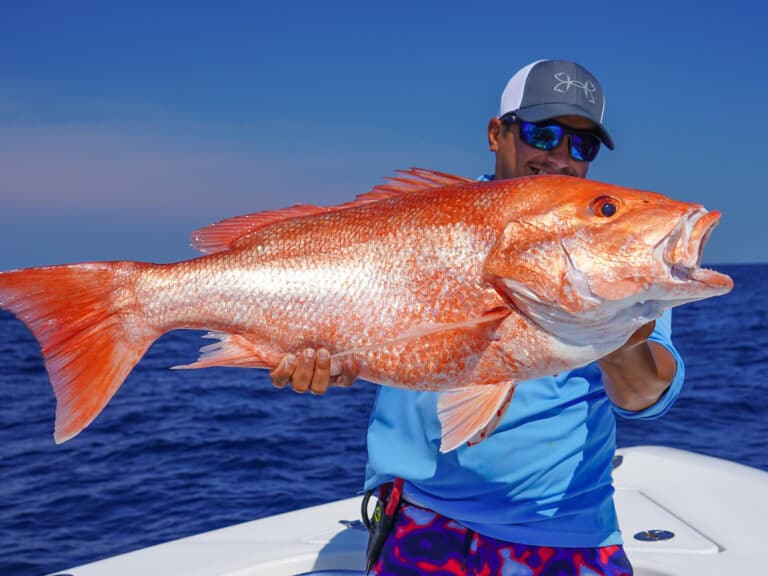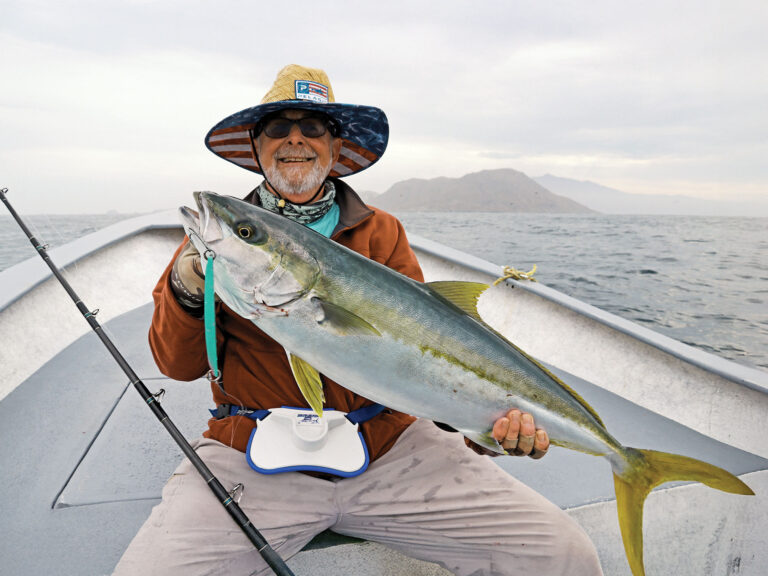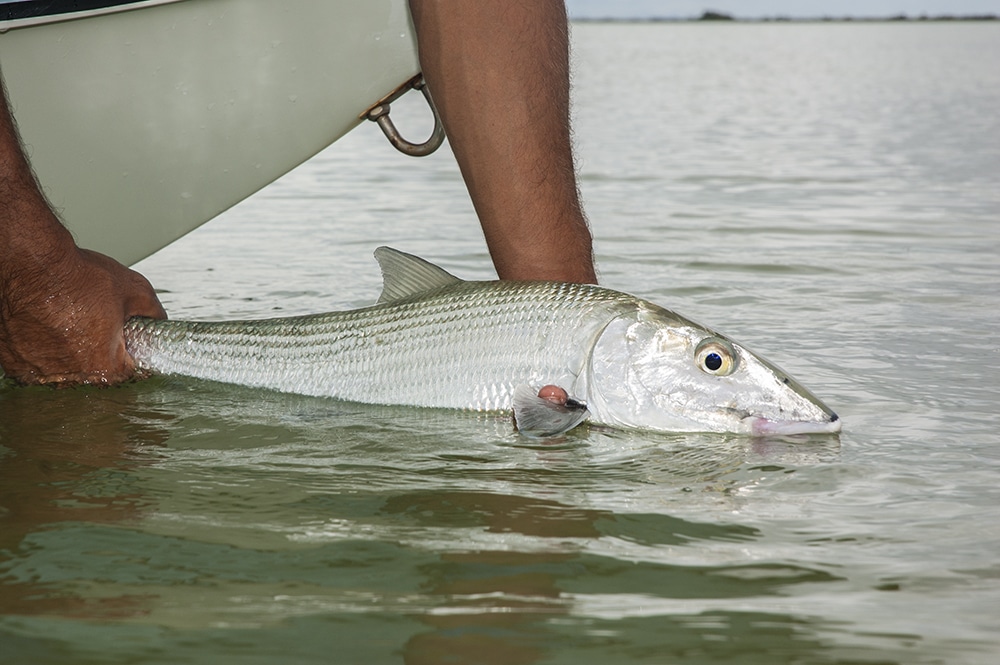
bonefish
Known worldwide as a premiere fly and light tackle target, bonefish are predominately a coastal species, commonly found in intertidal flats, mangrove areas and deeper adjacent waters. The bottom of the flats they inhabit varies in composition from sand or grass to coral and rocky substrates. They do not always travel in schools, these fish are often found singly or in pairs. Schools of similar sized bones may consist of 4-6 individuals, or number in the tens or hundreds. Large adult specimens, however, are more solitary.
Bonefish, also know as the gray ghosts of the flats, have bright silver scales on the sides that reflect the bottom, like mirrors, and blue-greenish backs with dark streaks that blend extremely well with the grass that covers the bottom of many flats. Juvenile bonefish exhibit a series of nine dark cross-bands on their backs, which fade as the bonefish grows. Beyond about 3 inches, the dark longitudinal streaks characteristic of the adults begin to appear and the last of the cross-bands become obscured. It is this natural camouflage that allows the fish to remain largely undetected by anglers and their natural predators.
Their body is slender, round, and compressed, more so in large specimens than in young adults. The first few rays of the dorsal fin are higher than the following rays and this lends a somewhat triangular shape to the dorsal fin when erect. The caudal fin (the tail) is quite large and helps the fish outrun most predators, attaining speeds of nearly 30 mph. The tail is deeply forked. The upper lobe is slightly larger than the lower and it often protrudes above the surface of the water when bonefish cruise or feed in shallow water.
Another distinctive characteristic is the bonefish’s inferior mouth and conical nose that extends a third of its length beyond the mandible and is used to dig through the seabed to root up its prey. Granular teeth, forming specialized dental plates, cover the tongue and upper jaw of the bonefish. Similar grinders are also present in the throat. The bonefish uses these modified teeth to grind mollusks and crustaceans.
In South Florida and the Bahamas, their prey consists primarily of crustaceans (xanthid crabs, portunid crabs, alphiid shrimp, penaeid shrimp), mollusks (clams and snails), polychaete worms, and small fish (primarily the gulf toadfish Opsanus beta). In certain areas, glass minnows become the main source of food, as is the case in parts of the Caribbean and Los Roques, Venezuela.** **
Species:
Bonefish were once thought to be a single species worldwide, but more than nine species have now been identified. There are 3 species in the Caribbean and western Atlantic — Albula vulpes being the largest and most widespread, and at least 6 species in the Pacific.
Bones may live in excess of 20 years, but they reach sexual maturity at 2 to 3 years of age, when they are between 17 and 19 inches long. Depending on the species, however, near ripe females may be as small as 9 inches. Spawning occurs year-round, but the fish are less reproductively active during the hot summer months, so spawning peaks from November through June.
After bonefish spawn, the larvae that hatch from the eggs drift in the open ocean for an average of 53 days. During this lengthy planktonic stage, the larvae may be pushed by the currents onto local shallows to become miniature versions of their parents, or they could get carried off to locations far removed.
In the Caribbean and western Atlantic, larger Albula vulpes juveniles (pre-adults) are known to live mostly on open sandy bottoms in deeper water than anglers usually fish for the adults. In fact, many of the bonefish creating large muds in 4 to 6 feet of water are those pre-adults. A lot of juvenile bonefish have been found along sandy beaches and open sandy shallows, but nearly all have been Albula garcia – not the species caught by recreational anglers.
Research has shown that bonefish in the Bahamas and Caribbean have a slower growth rate than in the Florida Keys. In the Caribbean a 23-inch (fork length) bonefish is 16 years old, in the Florida Keys a bonefish that size is 10 years younger.
In the Caribbean and western Atlantic, bonefish reach a maximum length of about 31 inches and a weight of 13 to 14 pounds. The average bones encountered by anglers in Florida and the Bahamas range from 4-6 pounds, and fish over 8 pounds are considered large. However, bonefish in Africa and Hawaii (Albula glossodonta, a different species), may attain weights over 20 pounds.
Locations:
Bonefish inhabit tropical and warm temperate waters worldwide. In the western Atlantic, they are occasionally taken as far north as North Carolina, but this species is most plentiful in South Florida, the Bahamas and Bermuda. To the south, bonefish range throughout the Caribbean and part of South America (from Colombia to Brazil). On the eastern Pacific coast, bonefish occur from San Francisco Bay, California, south to Peru and west to Hawaii.** **
Techniques:
Although small fish schooling in deeper water are sometimes caught bottomfishing in Southern California and Hawaii, most bonefishing is done stalking the fish, either by wading or poling a shallow draft boat, and sight-casting at schools or individual fish spotted cruising or tailing in skinny water.
Notoriously wary, bonefish demand a stealthy approach and accurate casts delivered just far enough ahead to keep from spooking an incoming school or individual specimen. When fishing for mudding fish in water waist-high or deeper, natural or artificial offerings must be cast on the outskirts of the mud and worked very slowly across it to not alarm the feeding fish.
Baits, like live shrimp and small crabs, or cut conch (in the Bahamas) are popular choices. A variety of lures, from skimmer jigs to small soft-plastic shrimp and crab imitations, ranging in weight from 1/16- to ¼-ounce, work well also. And there’s a wide range of proven flies, from old standards like the Clouser Minnow and Crazy Charlie to more innovative patterns like the Borski Bonefish Slider, Dorsey Kwan and many more.
Tackle:
Light spinning gear, 6- to 12-pound class, with a 7- to 7 ½-foot rod and a matching reel with enough capacity for 200 yards of line. If you prefer braid over mono, be sure to add a 20- or 30-foot mono or fluorocarbon topshot to keep from spooking the fish. An 8- or 9-weight fly outfit is also ideal, although expert flyrodders often scale down to a 7- or even a 6-weight for smaller bones or when the wind is calm and the fish are more jittery than usual. A 9- or 9 ½-foot fly rod will help prevent slapping the water on the backcast, more likely an issue when stalking bones on foot. And here also, a reel that holds at least 200 yards of backing is a good idea. Tapered leaders, at least 10 feet long, ending in 6- to-12-pound tippet are the norm.

